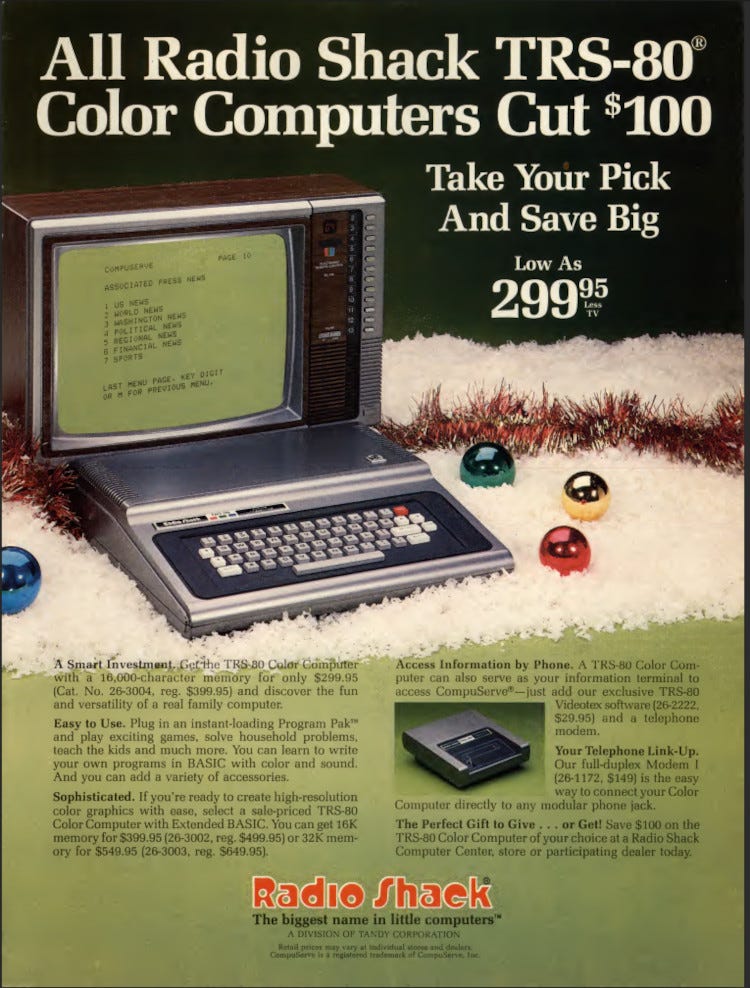Radio Shack TRS-80 Color Computers
Take Your Pick And Save Big
The Company
Radio Shack was founded in 1921 by brothers Theodore and Milton Deutschmann. They wanted to provide supplies for the new field of amateur radio. The name of the company was a reference to the small structures that housed a ship’s radio at the time. For a while, the company was disparagingly referred to as “Nagasaki Hardware” because most of the parts came from Japan, which was seen as a maker of low-quality parts. In 1939, the company would publish a mail-order catalog. They opened their first audio showroom in 1947 to demonstrate speakers, amplifiers, turntables, and phonograph cartridges.
After World War II, Charles Tandy joined his family’s business, the Hinckley-Tandy Leather Company. He started a mail-order business for leather crafts. By the 1960s, he wanted to diversify and get into the hobby electronics business. At the time, Radio Shack was having financial problems. Tandy purchased Radio Shack for the princely sum of $300,000. Tandy took Radio Shack from $4 million in debt to turning a profit within two years.
In the 1970s, Tandy got into the computer business with their line of TRS-80 computers. By the 1990s, Radio Shack was the largest PC maker in the world. They made computers for themselves, but also for other companies, including Digital Equipment Corporation. As the new millennium dawned, Radio Shack started to decline. (They also sold off the Tandy leather business.) Radio Shack never recovered from the decline. Eventually, the company filed for bankruptcy in 2015. In 2020, the remains of the company were purchased by a holding company.
The Computer
Radio Shack released its first personal computer, the TRS-80 Model 1, in 1977. Three years later, they released the TRS-80 Color Computer. The new line was also known as the Tandy Color Computer or just the CoCo. The Color Computer was a big departure from the previous models because it used the Motorola 6809E processor instead of the previously used Zilog Z80. (The Z80 is still being used for embedded systems to this day.) The Color Computer line consisted of three models: the Color Computer 1 released in 1980, the Color Computer 2 in 1983, and the Color Computer 3 in 1986.
Radio Shack’s own catalog had this to says about the Color Computer, “The all-new TRS-80 Color Computer features vivid color graphics, instant-load Program Paks, expandability and sound at a low price you won’t believe. Since it attaches to any color television set, it can easily be used anywhere for home, personal, or educational uses. Easy-to-use Program Paks program your Color Computer instantly for a variety of games and personal uses. Just pop one into the computer, and you’re ready to go!”
Here is the spec list for the Color Computer 1:
a Motorola 6809E processor running at 0.895 MHz
a 53-key “chiclet” keyboard, with arrows, BREAK, and CLEAR keys
uppercase-only text mode with 32 column by 16 lines
eight graphics modes, including 64 by 32 with eight colors and 256 by 192 with four colors
one RS-232 port (the so-called bitbanger port)
sound output with a 6-bit digital-to-analog converter
1500-baud cassette I/O for storage
a slot for plugging in cartridges known as “Program Paks”
You can read about the differences between the three Color Computer models here.
John Steiner wrote an article for the March 1983 issue of Creative Computing entitled “Getting Serious With The Color Computer”. In the article, he said, “When I compare the Color Computer with other home computer systems, I am impressed with the TRS-80 cost/feature ratio. It provides many features and capabilities that are unheard of on systems that cost twice as much. The Color Computer, coupled with the disk system is sure to make large inroads in the home computer market. I have found over the last year that the system is vastly underrated, and has far greater capacity than most people give it credit for.”
The following year, Creative Computer published an article entitled “Top 12 Computers of 1984”. In the article, David Ahl said the following, “Edging into first place by a hair was the Radio Shack Color Computer. While not as much educational software exists for the Color Computer as for the Commodore 64, it is generally of better quality. Furthermore, Radio Shack has a substantial corporate commitment to support the education market compared to virtually none at Commodore.” Not exactly overwhelming praise.
Digital Deli (edited by Steve Ditlea) had an interesting take on the distribution of early PC options. In the book, Lawrence C. Falk noted, “Just as pickup trucks and jeeps are more common in rural areas than in big cities, so certain personal computer models are more at home here. When IBM introduced its personal computer, the company ran magazine ads portraying Main Street U.S.A. and the many business uses for a PC in small-town America. The truth is that small businesses here are as likely to have a Radio Shack TRS-80 Model II or III or 4 as an IBM. Because the Radio Shack chain reaches into areas where ComputerLands and KMarts are unknown, their models tend to be more popular. The inexpensive Color Computer, for example, received only lukewarmly in major urban areas, has become a favorite and has inspired an unprecedented outpouring of homespun software.”
Extra Links
What computer ads would you like to see in the future? Please comment below. If you enjoyed it, please share it with your friends and relatives. Thank you.



Lewis Kornfeld, the father of the TRS-80, was an interesting character. I reviewed his memoir on the effort here: https://schmud.de/books/to-catch-mouse-make-noise-like-cheese.html